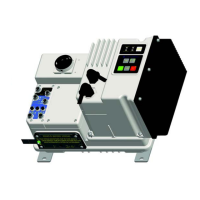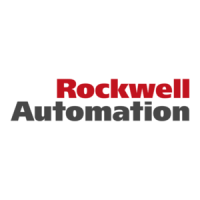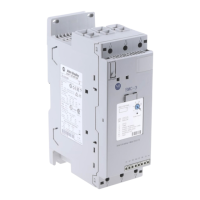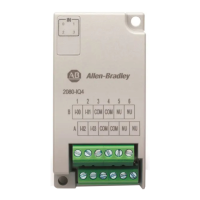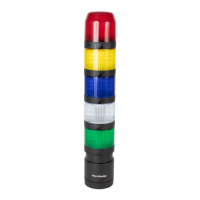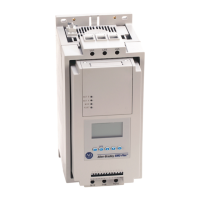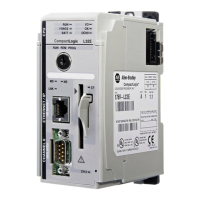Do you have a question about the Rockwell Automation ArmorStart Bulletin 280G and is the answer not in the manual?
| Brand | Rockwell Automation |
|---|---|
| Model | ArmorStart Bulletin 280G |
| Category | Controller |
| Language | English |
Describes the integrated, pre-engineered starters and enclosure design for various applications.
Details the safety version integrated into DeviceNet Safety installations for Category 4 functionality.
Details operating modes (Full-Voltage Start, Sensorless Vector Control) and key features like Overload Protection.
Explains the status LEDs for power, run, network, fault and the fault diagnostic capabilities.
Covers inputs, ArmorConnect, DeviceNet capabilities, DeviceLogix, and ZIP communication.
Lists general safety, ESD, and specific application precautions for 280G/281G and 284G models.
Provides physical dimensions and terminal designations for various ArmorStart models.
Covers wiring procedures, terminal designations, cable ratings, and ArmorConnect media.
Provides guidelines for Electromagnetic Compatibility, grounding, and physical separation of wires.
Explains parameter programming using RSNetWorx and lists parameter groups like DeviceLogix and DeviceNet.
Details DeviceLogix parameters (Inputs, Outputs) and Starter Protection (Reset Mode, Enable, Reset).
Covers parameters for AutoRun Zip, Zone EPR/PIT, MAC ID, Health, Mask, Offset, and Control.
Details parameters for Phase Current, Overload Class, FLA Setting, and Starter Setup.
Explains parameter programming and lists parameter groups including DeviceLogix, DeviceNet, and Display.
Covers parameters for Starter Status, Trip Status, Breaker Type, and Pr Fault settings.
Details parameters for Drive Control, DeviceNet faults, idle states, and network overrides.
Covers Motor parameters (Volts, Hertz, Current), PID setup, Accel/Decel times, and Fault Clear.
Details parameters for DC Brake, Skip Frequency, Autotune, and Compensation settings.
Explains setting unique node addresses using hardware switches or RSNetWorx software.
Describes how to build and register the EDS file for DeviceNet communication.
Explains selection of produced and consumed I/O assemblies for data exchange on DeviceNet.
Guides on programming motor FLA setting and overload trip class using RSNetWorx.
Demonstrates programming and explicit message examples for SLC and ControlLogix controllers.
Details using M0/M1 file areas and I/O mapping for explicit message requests/responses with SLC.
Describes initiating explicit messages in ControlLogix using MSG function and setting up the MSG instruction.
Explains DeviceLogix as a stand-alone Boolean program for logic within ArmorStart, requiring RSNetWorx.
Shows programming a logic routine to interface ArmorStart with a remote start-stop station using I/O.
Explains bit names for faults, status, outputs, and network bits used in the DeviceLogix ladder editor.
Describes configuring Zone Interlocking Parameters (ZIP) for peer-to-peer communication.
Explains enabling ZIP data production and consuming data from other devices using MacId parameters.
Shows organization of consumed data in the DeviceLogix Data Table for mapping and use.
Describes fault diagnostics, conditions causing faults, and enabling protective features.
Explains LED status indication and methods to clear faults remotely or locally.
Details specific faults, their causes, and corresponding LED indications for troubleshooting.
Provides a troubleshooting flowchart and fault LED indications for Bulletin 280G/281G units.
Provides a troubleshooting flowchart and detailed fault definitions for Bulletin 284G units.
Covers operation and troubleshooting for DB1 Dynamic Brake faults like Overtemperature and Overcurrent.
Describes internal drive faults and procedures for automatically clearing Type 1 faults.
Identifies causes and corrective actions for DeviceNet failures using the NETWORK STATUS LED.
Provides step-by-step instructions for removing and installing Control and Base modules for various models.
Lists electrical, mechanical, environmental, and connector specifications for Bulletin 280G/281G.
Lists electrical, EMC, overload, and DeviceNet specifications for Bulletin 284G.
Details mechanical, electrical, and pinout specifications for ArmorConnect media components.
Explains EDS files and lists product codes for DOL starters based on current rating.
Lists DeviceNet object classes and describes assembly formats for I/O communication.
Describes assemblies used for EDS file parameters and DeviceLogix data table mapping.
Details consumed and produced assemblies for standard controllers and network inputs.
Explains EDS files and lists product codes for Bulletin 284G variable frequency drives.
Lists DeviceNet object classes and describes assembly formats for the controller.
Discusses special behavior for DOP Instances 3, 4, 1, 2, 9, and 10, affected by various sources.
Lists class attributes for Parameter, Parameter Group, Input Group, and Output Group Objects.
Details attributes and services for Control Supervisor, Acknowledge Handler, Overload, and DeviceNet Interface Objects.
Details method of applying ArmorStart controllers using group motor installation rules per NEC and NFPA.
Lists mechanical, electrical, and pinout specifications for DeviceNet Media components.
Lists specifications, pinouts, and connectors for sensor media like DC Micro patchcords.
Details IP67 Dynamic Brake Resistor specifications, including ratings and approximate dimensions.
Lists components for ArmorStart Safety-Related Parts: controllers, safety module, and cables.
Details advantages of ArmorBlock Guard I/O, including IP67 package and DeviceNet communication.
Defines the safety function (uncontrolled stop) and lists limitations of safety-related parts.
Details configuration of the safety module and PLC program for safety function requirements.
Provides product selection guides for Control Module renewal parts for Bulletin 280G/281G.
Provides product selection guides for Base Module renewal parts for Bulletin 280G/281G.
Illustrates the part number structure for Bulletin 284G Control and Base Modules.
Describes the built-in PID loop and configurations like Exclusive Control and Trim Control.
Details PID Reference selection, Feedback source, and Deadband settings.
Explains PID Preload, Limits, Gains (Proportional, Integral, Differential) and adjustment guidelines.
Explains Step Logic, Basic Logic, Timer, and Counter functions for programming simple logic.
Details configuring Step Logic using Timed Steps and Basic Logic Functions with examples.
Details settings for Digits 3, 2, 1, and 0 in step logic parameters.
